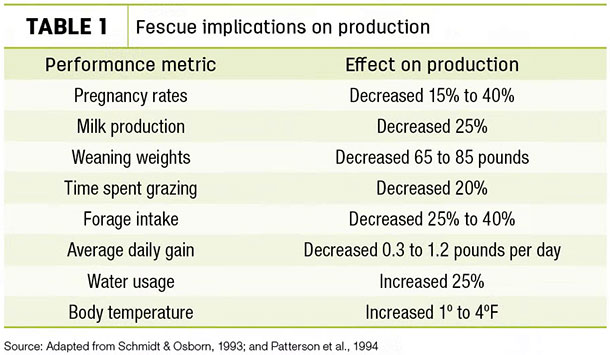Estimated as being established on over 45 million acres in the U.S., the hardy forage offers versatility and durability from an agronomic standpoint but, despite the forage quality on paper, cattle performance is impacted in the form of light calf weaning weights, reduced gain in grazing steers and replacement heifers, reduced milk production in cows and reproductive problems. In fact, the endophytic fungus associated with infected fescue represents over $600 million in losses of animal performance and health to the U.S. beef industry each year.
These performance losses are manifested in a number of ways. Table 1 demonstrates the implications of endophyte-infected fescue on cattle production with data compiled from multiple research trials using pastures with 70 percent or more endophyte-infected fescue.

In general, a couple of numbers to remember and expect with endophyte-infected fescue include:
- A reduction in daily gain of 0.1 pound for each 10 percent infection level of the pasture or hay
- A decrease in pregnancy rates of 3.5 for each 10 percent increase in infection level of the pasture or hay
- A decrease of 0.33 pound milk production for each 10 percent increase in infection level of the pasture or hay
Not only are these measurable performance indicators impacted, but cattle that previously consumed endophyte-infected fescue are typically rough-haired and unthrifty when entering the feedlot and, consequently, often discounted as feeders.
In a market where pounds and performance pay, there’s a lot of potential money left on the table if we’re not doing all we can to manage this forage and our cattle grazing it. In fact, it is estimated the average value loss of cattle grazing endophyte-infected fescue is $160 per cow per year since 2005.
A high-quality mineral designed to help defend cattle from the challenges of endophyte-infected fescue will cost you approximately 10 cents more per head per day than your traditional free-choice mineral program. That’s $18 per head for the summer grazing period or $36 per head year-round. With $160 per cow on the line, I wouldn’t hesitate to invest in a solid fescue mineral program.
Now, of course, nutritional management is not the only way to manage tall fescue. The endophyte that causes fescue toxicosis is contained in the seed and is consequently spread in that manner. Several methods have been suggested to alleviate the effects of fescue toxicosis in cattle consuming endophyte-infected fescue.
Management options
-
Dilution: This includes interseeding a companion forage such as clover, controlled supplementation with grain or grain byproducts, or the use of creep feeding or grazing. All of these methods work to dilute the consumption of the endophyte-infected fescue. These strategies are costly and labor-intensive – and often short-lived.
-
Vegetative growth: If we can prevent seedhead formation by clipping, continuous grazing or utilizing new pasture chemical herbicides, we can mitigate the problem. Not only is the fungus highly concentrated in the seedhead but, more importantly, by eliminating the formation of seedheads it maintains the grass in a more vegetative stage where it is of higher nutritive value.
Likewise, if hay is to be harvested, it is suggested it be baled in a more vegetative stage as well. So you aren’t actually doing anything to alleviate the toxic fungus but simply managing the forage to offer your cattle a higher-nutrition forage, which is just good management anyway.
-
Replace the infected fescue: Pasture renovation with endophyte-free varieties of fescue has been used with limited success, especially in the southern climates. The presence of the endophyte imparts specific advantages to the plant agronomically, which were the reasons fescue was so widely cultivated in the first place. New varieties of fescue have been commercially released recently which contain a novel endophyte that retains the agronomic advantages of endophyte-infected fescue but does not produce the poor animal performance associated with toxic endophyte-infected fescue.
This is obviously a good method because the problem forage (the endophyte-infected fescue) is replaced; however, it is expensive (the USDA suggests upward of $200 per acre) and requires tremendous management during the re-establishment period (not only the new forage but also the forage inventory to get you through until the renovated stand is ready for grazing or hay production). Additionally, the endophyte-infected seed in the soil and nearby non-renovated stands puts pressure on this new establishment.
- Mineral supplements: You can do all of the above to your pastures, but it’s going to require a lot of up-front and continuous labor and resources. But what if you chose instead to thrive with fescue? Producers can continue to reap the agronomic benefits of the forage but use a nutritional product that helps cattle compensate for the negative effects of the fescue grass or hay they eat.
A mineral supplement designed specifically for use with endophyte-infected fescue has shown great promise to help improve the overall health and performance of cattle while also helping to alleviate many of the symptoms associated with consuming the forage.
The product is focused on controlling the root cause of fescue toxicosis – the poisonous ergot alkaloids, namely ergovaline. These minerals should be fed to cattle grazing endophyte-infected fescue during the warm summer months and should also be fed to cattle consuming infected fescue hay during the winter months.
There isn’t one fix-all for dealing with fescue, but nutrition should not be an afterthought. With volatile cattle markets and well-documented performance implications of grazing endophyte-infected fescue, you should do all you can to make the most of your production scenario. ![]()
PHOTO: Cattle graze an endophyte-infected fescue pasture in the Fescue Belt. Photo provided by Cargill Animal Nutrition.

-
Tim Osborn
- Cargill Animal Nutrition
- Email Tim Osborn







